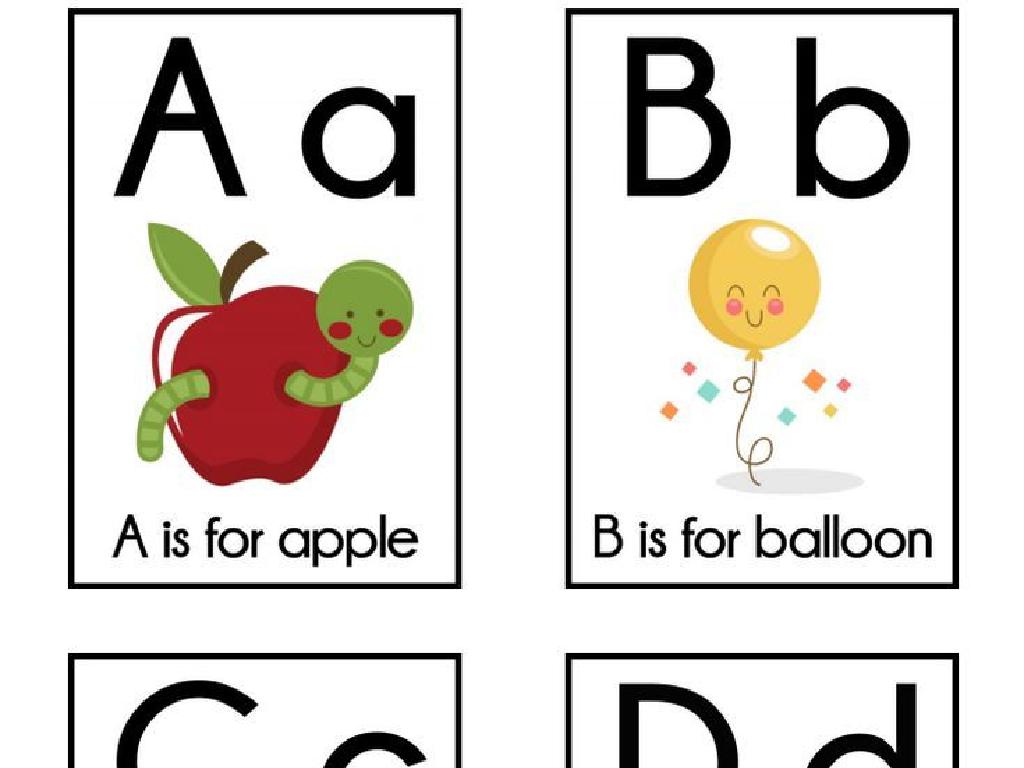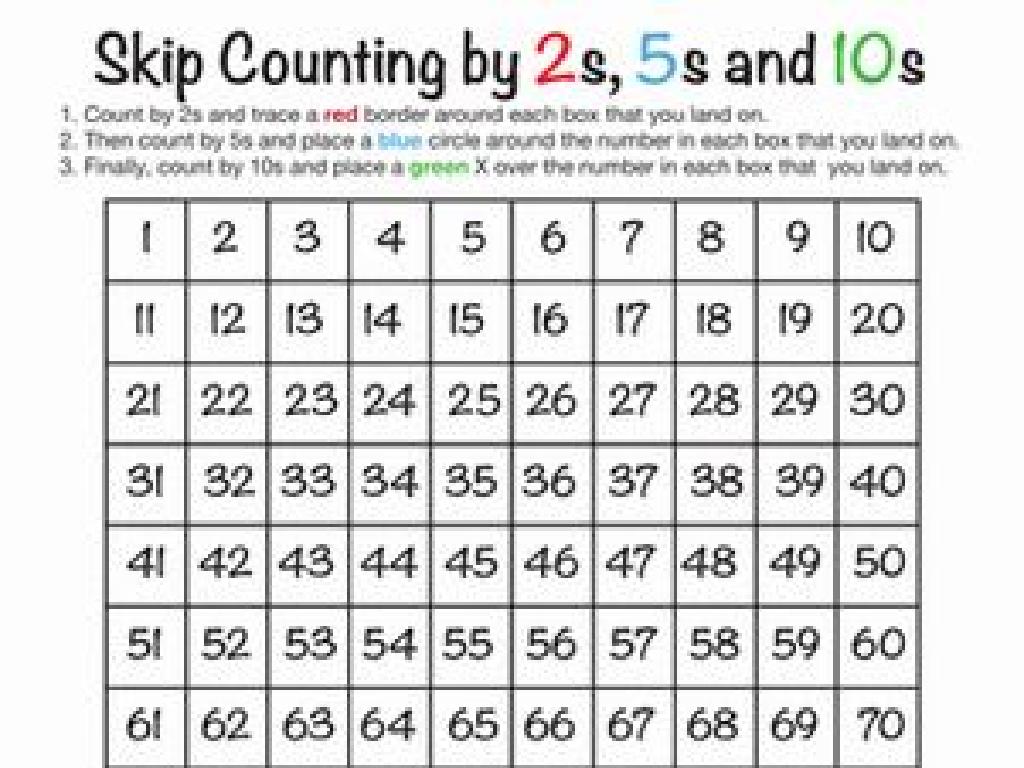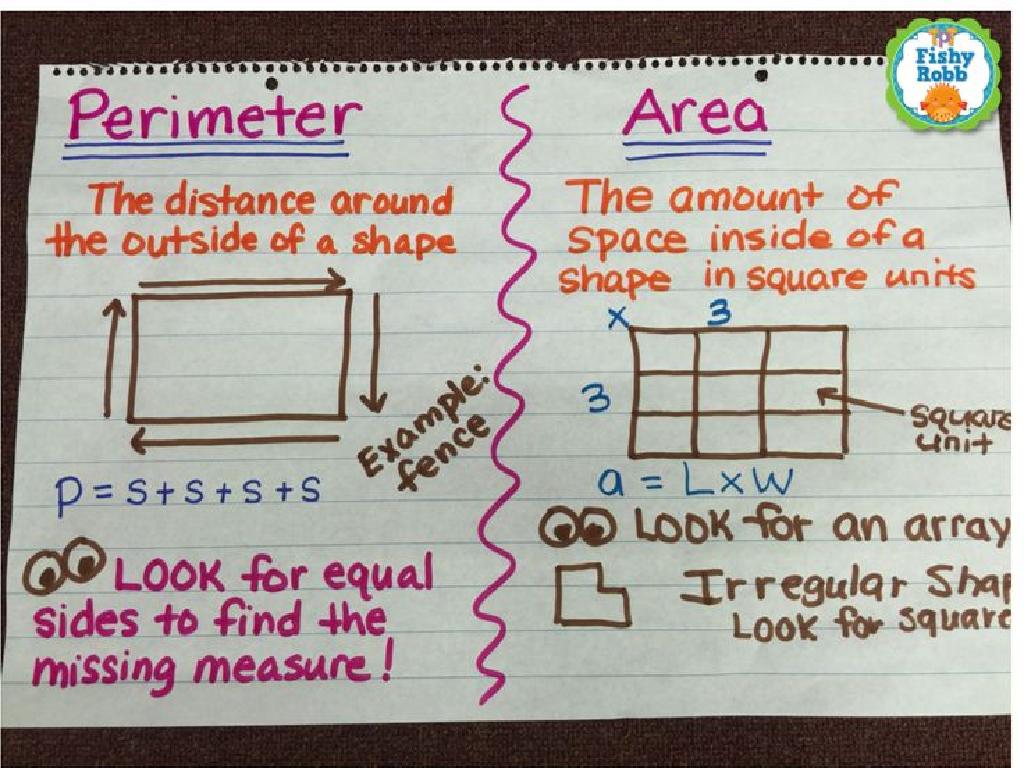Choose The Letter That Matches The Consonant Sound: C, G, H, W
Subject: Language arts
Grade: Pre-k
Topic: Letter-Sound Associations: Uppercase
Please LOG IN to download the presentation. Access is available to registered users only.
View More Content
Welcome to Letter Sounds!
– Discover special letter sounds
– Explore sounds for C, G, H, W
– ‘C’ as in ‘cat’, ‘G’ as in ‘go’, ‘H’ as in ‘hat’, ‘W’ as in ‘wig’
– Play and learn with letter sounds
– Become a letter-sound detective
– Find objects that start with each letter’s sound
|
This slide introduces young learners to the consonant sounds of the letters C, G, H, and W. Start by engaging the students with the concept of being ‘letter-sound detectives’ who will discover the unique sounds these letters make. Use visual aids and props to demonstrate the sound each letter represents, such as a toy cat for ‘C’, a toy goat for ‘G’, a hat for ‘H’, and a wig for ‘W’. Encourage the children to repeat the sounds after you and to look around their environment for objects that start with these sounds. This activity will help them associate the sounds with the letters and improve their phonemic awareness.
The Sound of ‘C’: Learning Consonant Sounds
– ‘C’ sounds like ‘K’ in ‘cat’
– Think of the ‘K’ sound at the beginning of ‘cat’
– ‘C’ also sounds like ‘S’ in ‘circle’
– Like the soft ‘S’ in ‘circle’ or ‘cent’
– Practice saying the ‘C’ sound
– We’ll say the ‘C’ sound as a class
|
This slide introduces the letter ‘C’ and its two different sounds to Pre-K students. Start by demonstrating the hard ‘C’ sound, similar to ‘K’, using the word ‘cat’ as an example. Then, explain the soft ‘C’ sound, which is like ‘S’, using the word ‘circle’. Engage the students by practicing the sounds together. Make sure to articulate the sounds clearly and encourage the children to repeat after you. Use visual aids like pictures of a cat and a circle to help them associate the sounds with the words. This activity will help students recognize the letter ‘C’ and understand its different sounds in preparation for reading.
The Sound of ‘G’
– ‘G’ sounds like ‘G’ in ‘goat’
– The hard ‘G’ sound is in words like ‘goat’, ‘game’, ‘gum’
– ‘G’ can sound like ‘J’ in ‘giraffe’
– The soft ‘G’ sound is heard in ‘giraffe’, ‘gem’, ‘giant’
– Practice saying the ‘G’ sound
– Repeat after me: ‘G’ as in ‘goat’, ‘G’ as in ‘giraffe’
|
This slide introduces the letter ‘G’ and its two sounds to Pre-K students. Start by demonstrating the hard ‘G’ sound, which is the same sound at the beginning of the word ‘goat’. Then, introduce the soft ‘G’ sound, similar to the ‘J’ sound, using the word ‘giraffe’ as an example. Engage the students by having them repeat the sounds after you. Encourage them to practice the sounds and think of other words that start with the letter ‘G’. This will help them associate the letter with its sounds and understand that ‘G’ can make different sounds depending on the word.
The Sound of ‘H’: Learning Consonant Sounds
– ‘H’ sounds like a soft breath out
– Example word: ‘Hh’ as in ‘hat’
– Think of blowing out a candle gently
– ‘H’ is a quiet and gentle sound
– Practice making the ‘H’ sound
– We’ll all try saying ‘Hh’ together in class
|
This slide introduces the consonant sound made by the letter ‘H’. Emphasize to the students that the ‘H’ sound is like a soft exhale, similar to gently blowing out a candle. Use the word ‘hat’ as a clear example to illustrate the sound. Encourage the children to notice how quiet and gentle the ‘H’ sound is compared to other sounds they’ve learned. During the class, practice the sound together by having the children mimic the sound after you. Make it interactive and fun by incorporating activities like pretending to blow on their hands to feel the breath associated with the ‘H’ sound.
The Wonderful Sound of ‘W’
– ‘W’ sounds like ‘Ww’ in ‘whale’
– ‘W’ is for ‘whale’, ‘water’, ‘window’
– Imagine blowing a soft whistle
– Pretend you’re whistling quietly
– Practice saying the ‘W’ sound together
– Let’s all say ‘Ww’ like in ‘whale’
– Listen for the ‘W’ sound in words
|
This slide introduces the consonant sound for the letter ‘W’. Start by demonstrating the ‘W’ sound and relate it to the word ‘whale’, which is familiar to children. Encourage the children to imagine they are softly blowing a whistle to make the ‘W’ sound. Have the class practice saying the ‘W’ sound together to reinforce learning. Finally, ask the children to listen for the ‘W’ sound in words during the day. This activity helps them connect the sound to the letter and recognize it in different contexts. It’s a fun and interactive way to learn letter sounds.
Matching Sounds to Letters
– Match sounds to correct letters
– Look at pictures for clues
– If a picture is a cat, what letter does it start with?
– Some letters have multiple sounds
– Letter ‘C’ can sound like ‘S’ in ‘cent’ or ‘K’ in ‘cat’
– Practice with examples
– We’ll try with ‘C’, ‘G’, ‘H’, ‘W’ using different pictures
|
This slide is designed to help Pre-K students associate the sounds they have learned with the corresponding uppercase letters. Use visual aids like pictures to make it interactive and engaging. For example, show a picture of a cat and ask students to choose the letter that matches the initial sound. Highlight that some letters, like ‘C’ and ‘G’, can produce more than one sound, and provide examples for each case. Encourage the children to participate by picking out the right letters for various pictures. This activity will reinforce their understanding of letter-sound associations and prepare them for reading.
Sound Match Game: Find the Letter!
– Match pictures to letters
– Listen for the consonant sounds
– Sounds like ‘kuh’ for C, ‘guh’ for G, ‘huh’ for H, ‘wuh’ for W
– Choose the correct letter
– Let’s play and learn together!
|
This interactive class activity is designed to help Pre-k students associate consonant sounds with their corresponding letters. Display pictures that start with C, G, H, and W, and play the sounds for each. Encourage the children to listen carefully and then select the letter that matches the sound they hear. For example, show a cat for ‘C’, a goat for ‘G’, a hat for ‘H’, and a whale for ‘W’. This will reinforce their understanding of letter-sound associations in a fun and engaging way. Be prepared with a variety of images and ensure to praise the students for their attempts, whether correct or not, to build their confidence.
Super Sound Detectives: Review Time!
– Celebrate your sound discoveries
– Letters have unique sounds
– C can sound like ‘k’ as in ‘cat’ or ‘s’ as in ‘cent’
– Sounds can vary for letters
– G can be ‘g’ as in ‘go’ or ‘j’ as in ‘giraffe’
– Keep practicing your listening skills
– H is always ‘h’ as in ‘hat’, and W is ‘w’ as in ‘wind’
|
Well done to all the little sound detectives for completing the activity! It’s important to remember that some letters, like C and G, can make different sounds depending on the word. Reinforce this concept with examples and encourage the children to continue practicing by listening to words and identifying the sounds. Keep the learning fun and engaging by praising their efforts and progress. You can also incorporate games and songs that highlight these consonant sounds to reinforce their learning.






